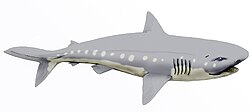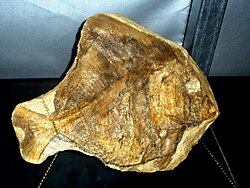Top Qs
Timeline
Chat
Perspective
Agua Nueva Formation
Geologic formation from the Cretaceous period From Wikipedia, the free encyclopedia
Remove ads
The Agua Nueva Formation is a geologic formation in Mexico. It preserves fossils dated to the latest Cenomanian and Turonian ages of the Cretaceous period. It consists "predominantly of alternating fossiliferous, organic matter-rich, laminated, dark gray limestone and non-laminated, organic matter-poor limestone in decimeter-thick beds (10 to 30 cm) with occasional centimetric beds (5 cm) of brown shale that show no apparent internal structures."[1] The formation is noted for its qualities as a Konservat-Lagerstätte, with notable finds including the plesiosaur Mauriciosaurus, the mosasaur Yaguarasaurus and sharks Ptychodus and Aquilolamna.
It appears to have been deposited on the upper part of a shallow continental shelf.[2]
Remove ads
Fossil content
Summarize
Perspective
Color key
|
Notes Uncertain or tentative taxa are in small text; |
Cartilaginous fish
Ray-finned fish
Based on Amalfitano et al (2020):[8]
Lobe-finned fish
Reptiles
Mosasaurs
Plesiosaurs
Molluscs
Cephalopods
Remove ads
See also
References
External links
Wikiwand - on
Seamless Wikipedia browsing. On steroids.
Remove ads













